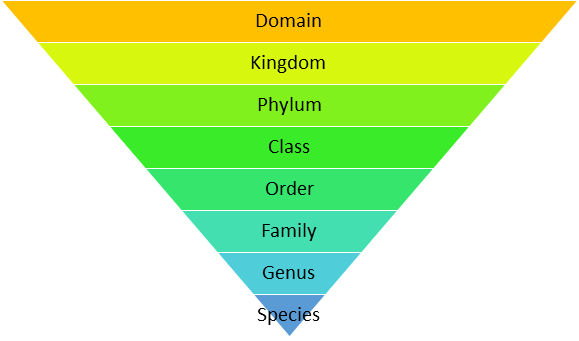
when we go from species to the kingdom in a taxonomic hierarchy, the number of common characteristics will?
(a)Will decrease
(b)Will increase
(c)Remain the same
(d)May increase or decrease
Answer
564.3k+ views
Hint: All living organisms are classified into different hierarchical levels depending on the common characteristics. The number of common characteristics is higher in the lowest taxonomic level common characteristics will be less in higher taxonomic levels.
Complete answer:
When we go from the lowest hierarchical level (species) to the highest hierarchical level ( kingdom) in a taxonomic hierarchy, the number of common characteristics will decrease. Let's take an example of the apple tree, scientific name- Malus Domestica, and the single-celled algae Chlamydomonas where both comes under the kingdom Plantae, but they do not have any common factors other than the similarity of have only one similarity that both produce chlorophyll and have a cell wall.
Additional Information: -Organisms with common characters are grouped or submerged into taxa and these groups are provided with a taxonomic rank.based on similar characteristics these groups are further segregated to create a different hierarchical level.
-Taxonomy is a sub-discipline of life-science which is usually practised by biologists called taxonomists. Taxonomists aim to define and classify life, also the classification directed by taxonomists is vital for the study of conservation of biodiversity
So, the correct answer is ‘Will decrease’
Note: -In history organisms were first categorized by Aristotle in Greece,383–321 BC where he classified organisms by their body organs and by other characters such as giving live birth, a number of legs, laying eggs, having blood, etc.
-Carl Linnaeus who is a Swedish botanist, is known as the "father of taxonomy". They revolutionized modern taxonomy With his major works such as “Systema Naturae”,” Species Plantarum” etc.
-The current taxonomic classification system has 8 major ranks which are Domain, Kingdom, Phylum, Class, Order, Family, Genus, and Species

Complete answer:
When we go from the lowest hierarchical level (species) to the highest hierarchical level ( kingdom) in a taxonomic hierarchy, the number of common characteristics will decrease. Let's take an example of the apple tree, scientific name- Malus Domestica, and the single-celled algae Chlamydomonas where both comes under the kingdom Plantae, but they do not have any common factors other than the similarity of have only one similarity that both produce chlorophyll and have a cell wall.
Additional Information: -Organisms with common characters are grouped or submerged into taxa and these groups are provided with a taxonomic rank.based on similar characteristics these groups are further segregated to create a different hierarchical level.
-Taxonomy is a sub-discipline of life-science which is usually practised by biologists called taxonomists. Taxonomists aim to define and classify life, also the classification directed by taxonomists is vital for the study of conservation of biodiversity
So, the correct answer is ‘Will decrease’
Note: -In history organisms were first categorized by Aristotle in Greece,383–321 BC where he classified organisms by their body organs and by other characters such as giving live birth, a number of legs, laying eggs, having blood, etc.
-Carl Linnaeus who is a Swedish botanist, is known as the "father of taxonomy". They revolutionized modern taxonomy With his major works such as “Systema Naturae”,” Species Plantarum” etc.
-The current taxonomic classification system has 8 major ranks which are Domain, Kingdom, Phylum, Class, Order, Family, Genus, and Species

Recently Updated Pages
Master Class 11 Social Science: Engaging Questions & Answers for Success

Master Class 11 Physics: Engaging Questions & Answers for Success

Master Class 11 Maths: Engaging Questions & Answers for Success

Master Class 11 Economics: Engaging Questions & Answers for Success

Master Class 11 Computer Science: Engaging Questions & Answers for Success

Master Class 11 Chemistry: Engaging Questions & Answers for Success

Trending doubts
What is meant by exothermic and endothermic reactions class 11 chemistry CBSE

10 examples of friction in our daily life

One Metric ton is equal to kg A 10000 B 1000 C 100 class 11 physics CBSE

Difference Between Prokaryotic Cells and Eukaryotic Cells

1 Quintal is equal to a 110 kg b 10 kg c 100kg d 1000 class 11 physics CBSE

Draw a diagram of nephron and explain its structur class 11 biology CBSE




